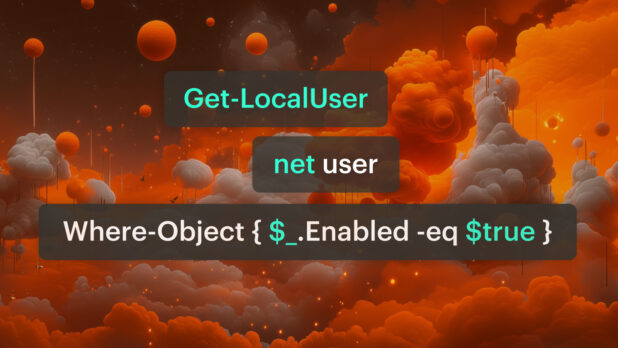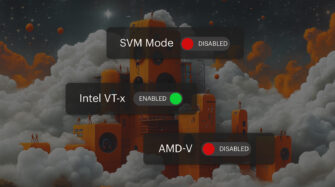PowerShell vs CMD: Sometimes, the problem you’re trying to solve will determine which one of these scripting languages to use. You can’t use CMD on a Mac, for instance, and PowerShell may be overly complex for Level 1 technicians who need to create a simple directory.
This post is a handy reference for PowerShell vs CMD, with examples and guidance on when to use each. Whether you’re an experienced system administrator or new to command-line interfaces, this article will help you use these scripting tools effectively.
Core differences between PowerShell and CMD
Command structure and syntax
CMD inherits its syntax from MS-DOS, meaning commands are often short words or abbreviations followed by slash-based switches (for example, dir /w). PowerShell uses a Verb-Noun command (cmdlet) structure, like Get-ChildItem for listing files. It also supports aliases that mirror well-known commands:
- dir → Alias for Get-ChildItem
- cd → Alias for Set-Location
- copy → Alias for Copy-Item
Parameters in PowerShell often have readable names preceded by a hyphen, making scripts easier to interpret. Error handling and tab completion further simplify command usage.
Output handling and data manipulation
CMD outputs plain text, which must be parsed manually for any advanced manipulation. In contrast, PowerShell outputs .NET objects that retain properties and methods. This approach enables powerful data handling through pipelines, allowing you to filter, sort, and modify results efficiently. For instance:
CMD Example:
dir | find "log"
PowerShell Example:
Get-ChildItem | Where-Object { $_.Name -like "*log*" } | Sort-Object LengthIn the PowerShell example, objects flow through the pipeline, enabling more sophisticated operations without external tools.
Feature comparison: PowerShell vs CMD
Scripting capabilities
Batch files in CMD (.bat or .cmd extensions) allow sequential command execution, simple loops, and conditions. Though reliable for quick tasks, they lack PowerShell’s extensive scripting features. PowerShell scripts (.ps1 files) include:
- Structured control flow (if/else, switch, loops)
- Functions, modules, and classes for code organization
- Integrated error handling (try/catch blocks)
- Access to .NET classes and libraries
- Execution policies for script security
These capabilities make PowerShell the stronger choice for most automation scenarios.
System administration and management
CMD provides core commands like ipconfig, net user, and sc (Service Control), to cover basic tasks. PowerShell offers specialized modules for Active Directory, networking, security, and more.
PowerShell integrates with Azure, AWS, and other cloud platforms, and PowerShell Remoting executes commands on remote machines.
PowerShell vs CMD in action
File and directory management
CMD: copy C:\Logs\example.txt D:\Backup\
PowerShell: Copy-Item -Path C:\Logs\example.txt -Destination D:\Backup\
PowerShell’s cmdlets include extra parameters, allowing conditional file selection or time-based filters. In CMD, you often need multiple commands or manual parsing to achieve similar results.
User and permission management
CMD (local user creation): net user johndoe MyPassword123 /add
PowerShell (local user creation):
New-LocalUser -Name "johndoe" `
-Password (ConvertTo-SecureString "MyPassword123" -AsPlainText -Force)PowerShell supports more properties and secure password handling. It also has Active Directory cmdlets, making large-scale management easier.
System information and diagnostics
CMD: systeminfo (Generates raw text that can be time-consuming to parse in scripts).
PowerShell: Get-ComputerInfo (Returns structured objects, allowing targeted queries like):
Get-ComputerInfo | Select-Object OSName, OSVersion, WindowsProductNameTask automation
CMD uses schtasks for scheduling, while PowerShell provides cmdlets for creating and registering scheduled tasks with more options.
CMD Example: schtasks /create /tn “DailyBackup” /tr “C:\backup.bat” /sc daily /st 23:00
PowerShell Example:
$action = New-ScheduledTaskAction -Execute "PowerShell.exe" -Argument "-File C:\Scripts\Backup.ps1"
$trigger = New-ScheduledTaskTrigger -Daily -At 11pm
Register-ScheduledTask -TaskName "DailyBackup" -Action $action -Trigger $triggerPowerShell’s scripted approach streamlines complex tasks and offers a clearer, more maintainable configuration.
Recap: When to use PowerShell vs CMD
PowerShell
- Complex or large-scale administration tasks with scripts and modules.
- Data processing; working with detailed objects and piping outputs between commands.
- Handling user accounts, permissions, and policies in Active Directory.
- Desired State Configuration (DSC) to enforce system states.
CMD
- Simple tasks like listing files or pinging a server without needing advanced scripting.
- Running older batch files or maintaining scripts built on traditional DOS commands.
- Checking IP settings, connectivity, or verifying system details with minimal overhead.
Tap into your scripting superpowers with Syncro
Syncro’s powerful scripting engine helps IT teams and MSPs customize and automate tasks and workflows for maximum efficiency. Take Syncro for a spin and explore our community script library!
Share














